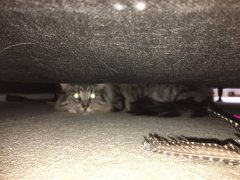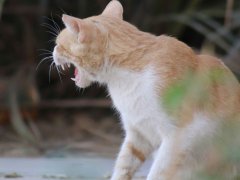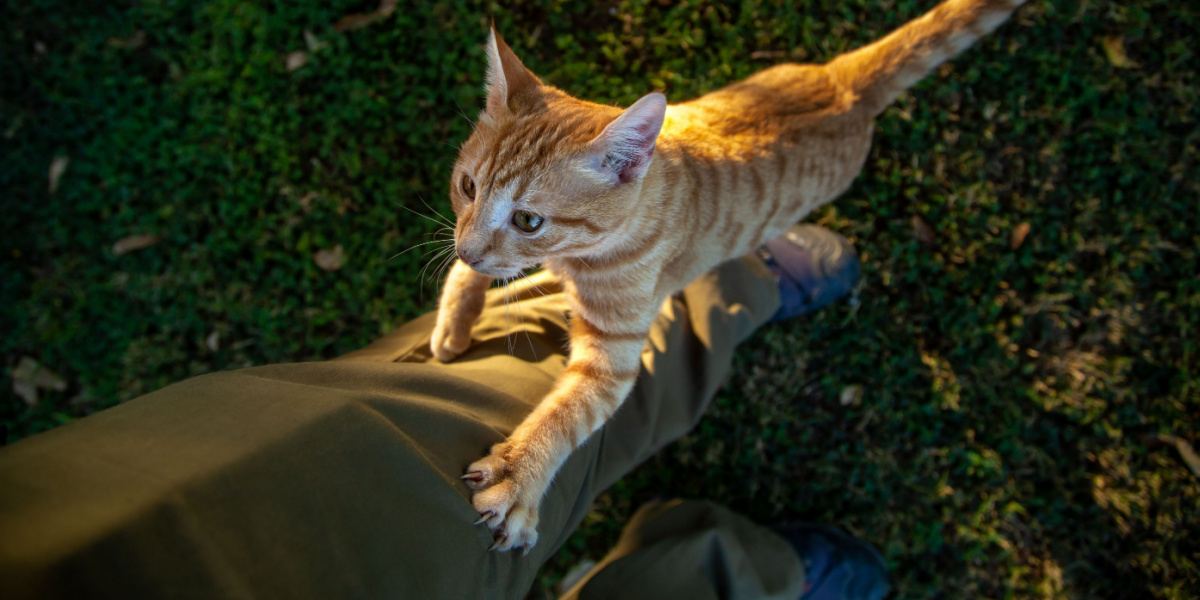
Cats exhibit many behaviors that we find strange, but your cat climbing up you as if you are a tree is not only bizarre, it’s painful, too!
Although this unwanted behavior is most commonly seen in kittens as they explore their surroundings and burn off some of their boundless energy, adult cats sometimes climb up people, as well.
Cats instinctively want to be up high so they feel safe and have the best view of their surroundings. Cats might also climb up their owners if they are craving attention, or are bored and have no other way to express their natural climbing instincts. To help stop the behavior, provide more enrichment and opportunities to climb by purchasing a cat tree, and make sure you spend more time with your cat.Key Takeaways
This odd feline behavior has many potential causes ranging from an instinctive need to be up high, to attention-seeking or boredom. Read on for more information about why your cat might be climbing you like a tree, and what you can do to stop them so your poor legs get some respite.
Also Read: New Cat Owner Anxiety: Why It Happens & How To Overcome It
Instinct To Climb
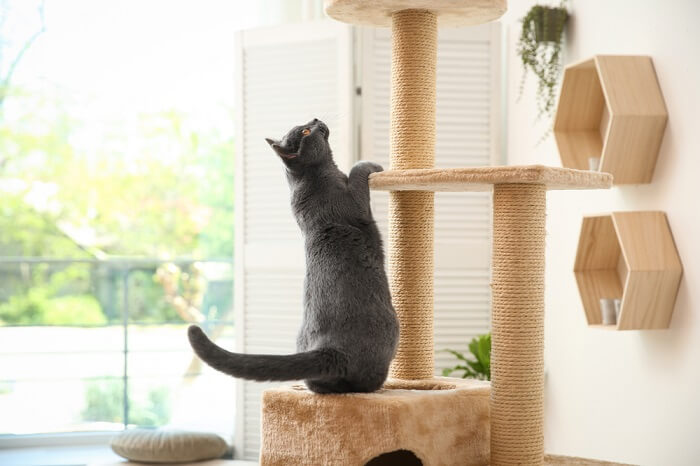
Domestic cats inherited their desire to climb high places from their wild ancestors.
Domestic cats (Felis catus) are part of the Felidae family, which contains 37 recognized species all thought to have evolved from a common ancestor in Asia 10 to 12 million years ago. The Felidae family also includes several species of wild cats, and large cats like lions, leopards, and cheetahs.
DNA samples from pet cats across the globe have been shown to be nearly identical to the DNA of the African wildcat (Felis sylvestris lybica), which still lives in Asia and North Africa today. Our domestic house cats also share more than 95% of their DNA with tigers!
Although not all species of cats spend much time climbing trees, many of them do, and it might be these instincts passed on from their wild-cat ancestors that make cats so keen to climb. Cats have strong hind legs, good balance, and natural athleticism, which combine to make them excellent at climbing up things like trees.
Getting high up provides cats with a better view of their surroundings, meaning they are safer from dangers such as predators and have a better vantage point for spotting prey. When cats live in social groups, dominant cats usually claim the highest resting spots.
You might find it a bit insulting that your cat thinks you look similar to a tree. In reality, it’s not that they think your legs look like a tree trunk or that your arms look like tree branches. People are often the tallest thing in a room and that is why cats may climb up us, acting on their instincts to find the perfect high spot.
Also Read: Why Does My Cat Lay And Sleep Between My Legs?
Does Your Cat’s Age Affect How Likely They Are To Climb You Like a Tree?

Kittens are prone to climbing up human legs using their claws, but most eventually outgrow this behavior.
Using their needle-sharp claws to scale up your legs is much more common in kittens than older cats. Kittens are curious, love to play and explore their new surroundings, have loads of energy, and are also testing out their abilities and skills.
All these factors, combined with an instinct to climb to high places mean that your legs provide the ideal location to practice their skills. Although nobody is disputing that it really hurts when they climb up you, it is really important to remember that they don’t realize this and are not doing it maliciously.
We will discuss methods to discourage the behavior later in this article, but it’s important to remember never to punish your cat as it will just make them scared of you and spoil your special bond.
Luckily, most young cats start to learn some boundaries as they get older, and also find it harder to climb up you as they get bigger and heavier.
Also Read: 10 Signs You Might Have A Clingy Cat
Boredom and Attention-Seeking
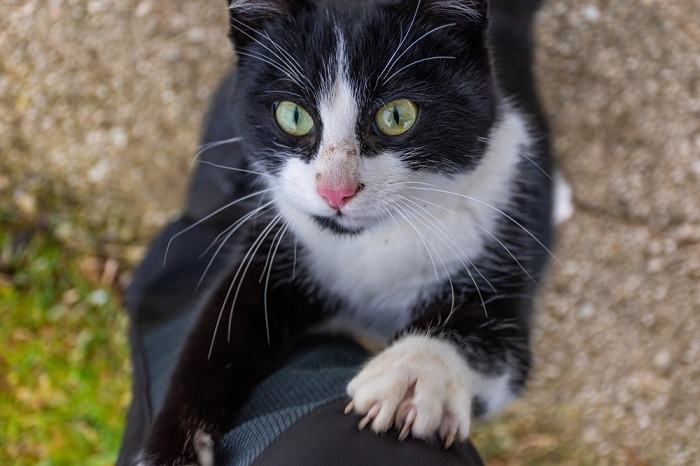
Cats that are feeling neglected might climb up your legs to gets some of your attention.
As a cat owner, I’m sure you’ll agree that it’s a myth that cats are aloof and don’t want attention from their owners. Although some cats seek out affection more than others, a study has proved what most of us already knew: that cats form strong attachments to their owners, and rely on us for security and affection.
If your cat feels that they are not receiving enough attention from you they might start looking for ways to make you notice them. Climbing up their owner’s legs may be their best bet, as there is no way anyone can ignore those needle-sharp claws and they will definitely get your attention!
Cats that are suffering from boredom might climb up people’s legs as an outlet for their excess energy. Indoor cats without environmental enrichment to provide opportunities for natural behaviors such as climbing and chasing prey can easily get bored and start climbing curtains, walls, and legs.
Also Read: Why Is My Cat So Annoying? Cat Attention-Seeking Behavior Explained
How Can I Stop My Cat Climbing My Legs
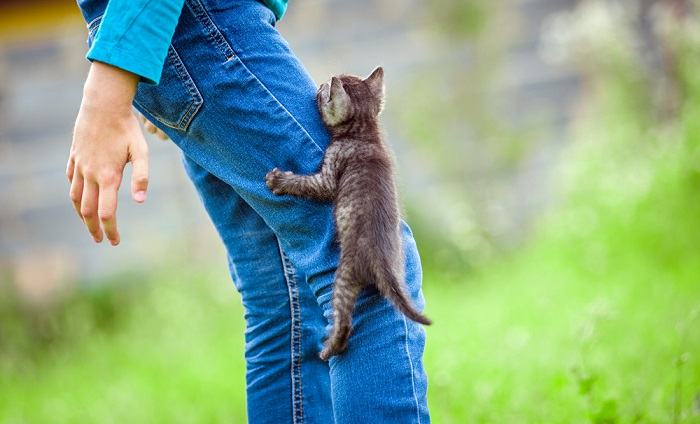
If your kitten starts climbing your legs, detach them and redirect to something more appropriate like a cat tree.
Let’s face it, cat claws are sharp, and no matter how much we love them, it’s impossible to indulge them in this behavior. So what is the solution? Punishing your cat is never advisable, and will only make them scared and fearful of you. Positive reinforcement by rewarding good behavior is a much better approach for our feline companions.
Thankfully, many kittens seem to grow out of climbing up legs as they reach adulthood, but if your cat needs a helping hand to stop here are some options to consider:
Provide another outlet for their climbing instincts. Provide high places in the house for your cat to climb up to such as a cat tree. If you don’t have a lot of space in your home you could put up some high wall shelves for your cat to climb instead.
Use catnip and/or pheromones to encourage your cat to use the cat tree. It’s also a good idea to put treats on each level for them to find as they explore.
Read more about how to encourage your cat to use a cat tree in our helpful article if they don’t seem to like it straight away.
If you see your cat in the classic crouched pose about to jump onto your leg, quickly move out of the way to avoid the situation happening, or distract them with a toy.
If your cat is climbing your leg, gently try to unhook them and place them on the floor.
Keep some cat toys handy and use your cat’s natural playfulness as a distraction if they look like they are planning to climb your legs. Wand, fishing, and feather toys often work well for this, but never leave your cat unattended with toys that contain long strings.
If you think your cat is suffering from boredom, ensure they have plenty of environmental enrichment such as toys, scratching posts, and a cat tree. You could also consider getting them a cat harness and leash so they can safely explore the outdoors with you.
If your cat seems to be climbing up you because they are craving more attention, ensure you spend as much time as possible bonding, playing, grooming, and fussing over them, which will hopefully solve the problem.
Indoor cats can have their claws clipped to prevent it from being so painful if they try to climb up you. This can be done by a groomer or veterinarian, or you can get some clippers and do it yourself at home if you feel confident. Outdoor cats should not have their claws clipped unless they are very overgrown as they need them for protection and to escape danger. Declawing is a mutilation that is never recommended.
Also Read: Why Declawing Is Bad for Your Cat & What To Do Instead
Final Thoughts
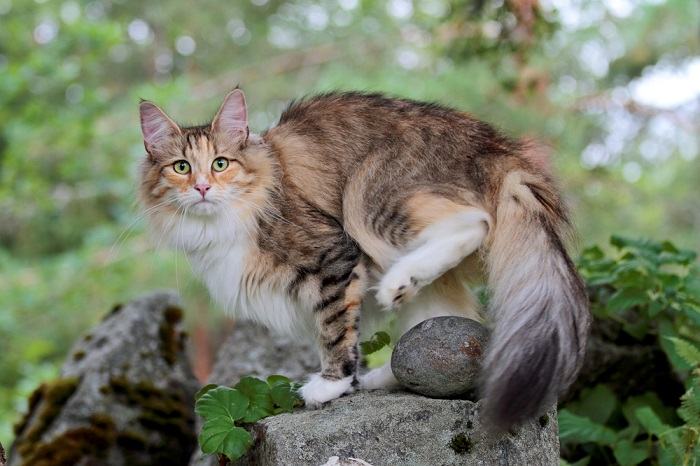
Taking some simple steps can stop your cat from trying to use you as a tree-top lookout.
Having your cat climb up your leg as if you are a tree can be a painful, unpleasant experience. After all, those claws are sharp!
Cats have an instinctive drive to be up high so they feel safe and have the best view of their surroundings, so if you happen to be the tallest thing in a room you might be a target. The behavior is most common in kittens as they race around burning off their boundless energy and testing out their climbing skills.
Cats might also climb up their owners if they are craving attention, or are bored and have no other way to express their natural climbing instincts. It’s important to never punish your cat for this behavior, even if they hurt you. Watch out for the signs your cat is about to leap onto your leg and either move out of the way or distract them with a toy.
Provide more environmental enrichment and opportunities to climb for cats that might be bored by purchasing a cat tree, and if your cat seems to be craving more attention make sure you spend more time with them, and hopefully the behavior will stop.
Also Read: 10 Subtle Signs Your Cat Is Frustrated
Frequently Asked Questions
Why does my kitten climb up me as if I am a tree?
Kittens are naturally curious and inquisitive, and spend their time exploring their new surroundings and testing out their skills and abilities. Cats instinctively like to be up high, and many kittens unfortunately see their owners’ legs as a good route to get to a prime location. Thankfully most kittens stop climbing legs and curtains as they grow older.
Why is my cat meowing at me and climbing up my leg?
If your cat is meowing at you and then climbing your leg it is likely that they are trying to get your attention because they want something. Sharp claws in an owner’s leg are a guaranteed way for them to get our attention.
It might be that they need some food or water, or it might be that they are craving some extra attention from you—try playing a game, grooming them, or giving them a fuss, and hopefully, that will satisfy them.
Why does my cat like to climb up me and sit on my shoulder?
Domestic cats are very closely related to their wild cat ancestors and share many of their behaviors and instincts. A high point such as your shoulder provides a safe place with a good view of the surrounding area to look out for potential prey or threats.
Dominant cats also tend to try to get to higher points so it could be a sign that your cat thinks they are in charge. It could also just be that they enjoy being as close to you as possible!
-
Cho, Y., Hu, L., Hou, H. et al. 2013. The tiger genome and comparative analysis with lion and snow leopard genomes. Nat Commun 4, 2433
-
Driscall, C.A., Menotti-Raymond, M. et al. (2007). The Near Eastern Origin of Cat Domestication. Science 317(5837):519-523
-
Vitale, K.R., Behnke, A.C., Udell, M.A.R. (2019). Attachment bonds between domestic cats and humans. Current Biology, 29(18), PR864-R865. https:doi.org/10.1015/j.cub.2019.08.036

